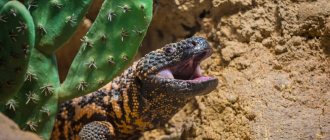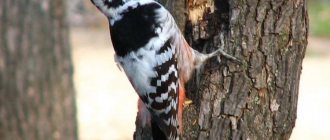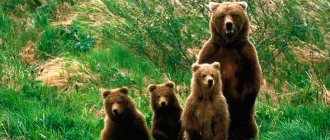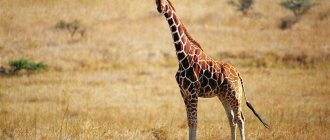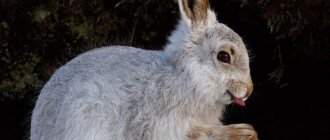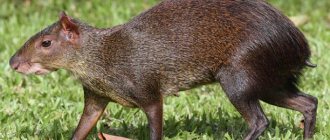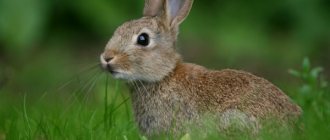Expert opinion
Dobryshev Sergey Anatolievich
Professional rabbit breeder and hare breeder with 30 years of experience
The wild or otherwise European rabbit has the honorable title of being the ancestor of all existing breeds, including decorative ones. In the process of evolution, their physiology has adapted to survive in very difficult conditions. Wild rabbits survive successfully despite infectious diseases, predators and other difficulties. Getting to know their characteristics and lifestyle helps to better understand the nature of domestic representatives, what they need, and proper care for them.
A brief excursion into the history of rabbits
The life path of furry animals goes back many millions of years, during which they survived many disasters and climate changes, managing to adapt to all the vagaries of nature.
Origin and evolutionary path
The order of lagomorphs, to which rabbits belong, appeared on earth about 65 million years ago during the Paleocene era. The formation of animals took place in Central Asia, from which they spread throughout the Northern Hemisphere. These animals were primitive mammals, and, judging by the fossil remains, they had an elongated body, long strong limbs and small round ears. Their diet consisted of grass, tree branches and leaves of bushes, and they did not move by jumping, like modern rabbits, but relied on all four paws when walking.
This is what the common ancestor of hares and rabbits looked like
A warm climate, an abundance of plant foods, and the absence of large predators contributed to the rapid evolution of small herbivorous mammals. Already in the Miocene, the hare family consisted of more than 200 species; they gradually acquired features inherent in modern hares and rabbits. About 35 million years ago, the ancient ancestors of the rabbit split from the lagomorphs, and their evolution took a different path. During the first ice age, which began 2.5 million years ago, rabbits, common throughout Europe, migrated south and settled in the Iberian Peninsula, where they safely survived all natural disasters and managed to survive to this day.
How and when were rabbits domesticated?
Compared to other domesticated animals, the domestication of rabbits is relatively recent and dates back to around the 2nd millennium BC. Judging by the surviving ancient scrolls, these animals were kept in Ancient Egypt and the Roman Empire, which was even mentioned by famous ancient historians.
But targeted breeding of rabbits began only in the early Middle Ages. and dates from around the 6th century. There is even a legend associated with furry animals, according to which Pope Gregory I officially declared rabbits... fish, thereby giving permission to eat rabbit meat during Lent. And the monks hastened to take advantage of this opportunity and began to breed these creatures at the monastic courts.
French monks managed to tame rabbits
Scientists, interested in this myth, examined ancient documents in detail and were able to prove that the story about dad and the rabbits is pure fiction. But what can be considered reliable is the fact that the French monks were actually the first to start raising rabbits, and even tried to breed new breeds.
From France, the experience of raising domestic rabbits migrated first to Belgium and Switzerland, and a little later farmers from Holland, Germany and England began breeding them. Over time, rabbit breeding spread not only throughout Europe, but also to other continents, and today their meat and fur remain in demand throughout the world.
Rabbit: general characteristics
These herbivorous animals are part of the order Lagomorpha and the family Lagoraceae, but represent a separate genus of rabbits. The body length of domestic rabbits ranges from 20 to 55 cm, and they weigh from 1.2 to 12 kg.
The rabbit is easy to recognize by its long ears and fluffy tail.
Contrary to popular belief, they do not belong to the class of rodents, because they differ from them not only in the structure of their teeth, but also in their method of movement.
Rabbits are small animals, with a squat, oval-shaped body and a short, heavily furred tail. The animals' front legs are short and weak, but their hind legs are powerful, with well-developed muscles. Rabbits move in short leaps, sometimes walk, but at the same time they look slow and clumsy. Domestic rabbits have thick, fluffy fur and a wide variety of colors.
These creatures have well-developed all senses, they see perfectly and have a sensitive sense of smell. And, of course, rabbits have excellent hearing, and they are able to increase the range of sound waves by turning their long ears to the sides and back.
Fluffy animals are distinguished by their shy and timid character; nature has not endowed them with sharp claws and teeth, so their only chance of not becoming dinner for predatory animals is to escape. But, when caught, these babies desperately fight for their lives, biting and kicking the enemy with their strong hind legs, which in rare cases helps them escape from the tenacious teeth of a hungry predator.
The life expectancy of domestic rabbits is 5-8 years; for decorative breeds this figure is much higher, and they can reach 12-15 years of age.
Elena
Ask a Question
Question to the expert
How is a rabbit different from a hare?
Well, at least because hares are larger in size than rabbits and have longer limbs. Hares undergo a seasonal color change, and in winter they turn white, while the fur of rabbits, including wild ones, remains unchanged throughout the year. And finally, hares, unlike rabbits, have never been domesticated, and continue to lead a free, free life in the wild.
Cubs
Baby rabbits are born completely naked, blind, deaf and helpless. The rabbit takes care of her babies for a long time and diligently. She will never feed other people's rabbits, no matter what the circumstances. The only option is typical for domesticated rabbits: you can give the rabbit other people's babies, but only so that the age does not exceed five to seven days, otherwise she will eat them. Bunnies are born fully formed. They immediately have fur, they see and hear perfectly, and can eat adult food almost after birth. The hare does not burden herself with caring for children. Having given birth to cubs under some bush, she most often leaves them forever. If her maternal instinct subsequently awakens, she may well feed someone else’s bunny, hoping that someone will feed her cubs in the same way.
Where do wild rabbits live?
Most people are sure that only hares live in the wild, and rabbits are kept as farm animals or as decorative pets. But this is not so, because domestic rabbits have wild relatives that are found on almost all continents.
You can meet a wild rabbit on any continent except Antarctica
The largest populations of these animals are found in the following parts of the world:
Recommended by topic
Horse Cow Camel
- North America;
- Northern and central South America;
- Southeast Asia;
- Sumatra Island;
- Japan;
- Southern and eastern countries of the African continent;
- Western and eastern parts of Europe;
- Scandinavia;
- Mediterranean countries.
Wild rabbits also live in Australia, and for this country they have become a natural disaster. The animals were brought there by European colonists in the mid-19th century for industrial purposes, but quickly went wild, and soon their population in the natural environment numbered millions of individuals. Thanks to their extreme fertility and the absence of large predators, rabbits managed to populate literally the entire Green Continent in 50 years. These creatures destroyed vegetation and farm crops, so local farmers declared a real war on the rabbits, and later the Australian government joined them.
The fight against furry pests in Australia continues to this day. The number of wild rabbits is controlled by shooting, and even by such a cruel method as extermination of animals by spreading the myxomatosis virus among them. And, although the number of animals has decreased, they still remain a problem, continuing to cause damage not only to farmers, but also to the country’s ecosystem.
Links
Wikimedia Foundation. 2010.
See what “Rabbits” are in other dictionaries:
RABBIT - RABBIT, Lepus cuniculus domesticus, rodents of the family. hare (Leporidae), are one of the most widely used laboratory animals (see) and are used for a wide variety of physiological, general pathological, but Ch. arr.... ...Big Medical Encyclopedia
RABBIT - (Oryctolagus), genus of Zaitsevs. Unity, wild species K. (O. cuniculus). Dl. body up to 44 cm, weight approx. 2 kg.. Rodina Center, and South. Europe, North Zap. Africa; Since the Middle Ages, it was brought to a number of European countries, later to Australia, New. Zealand, South... ... Biological encyclopedic dictionary
Lifestyle of rabbits in the wild
In terms of external parameters, wild rabbits are practically no different from their domestic relatives, except that they are smaller in size and cannot boast of such a variety of colors. Fluffy animals that live in their natural environment weigh from 400 g to 4 kg, they are painted in a solid gray or reddish color, individuals with white or black fur are less common.
The nondescript color helps wild rabbits blend in with their environment
Rabbits do not like dense forests and swampy regions; they prefer to settle in rough terrain: ravines, coastlines or abandoned quarries. They also choose the outskirts of populated areas, wastelands and landfills for residence, but at the same time they do not strive for close contact with people, and rarely set up their burrows in fields and gardens.
An important factor for animal settlement is soil structure. Rabbits need soft sandy soil to dig underground shelters, so they are not found in rocky and mountainous regions, and avoid areas with clay soil.
Lifestyle and behavior
In nature, rabbits lead a sedentary, collective lifestyle, and form large colonies of 50 to 70 individuals, occupying an area of approximately 0.5-20 hectares. Each colony, in turn, is divided into groups, which include 7-10 rabbits. Each family is headed by a dominant male and female; the remaining members of the clan are adults of both sexes and growing cubs.
Rabbits feel safer with their family
The family homes of wild rabbits are very interesting, they are real underground labyrinths and serve as a home for many generations. The deepest hole with several exits is occupied by the leadership couple of the clan, and in the remaining rooms, which are more modest in size, live animals of lower status. What is also noteworthy is that for giving birth and raising offspring, females dig special brood burrows, choosing a place for them at some distance from the main shelter.
The activity of wild rabbits depends on their habitat. If the animals live away from highways and are not bothered by four-legged enemies, they are active during the daytime. In close proximity to predators, rabbits are forced to feed in the dark and hide in their dens at dawn.
Diet of rabbits in the wild
Rabbits are unpretentious in their choice of food and eat all the plants available to them. After all, animals stay close to their burrows while feeding, so their menu is not very diverse. In summer, the diet of furry creatures consists of green grass, cereals, seeds, tubers, leaves and plant roots. Animals living near fields do not miss the opportunity to eat carrots, cabbage and lettuce. In winter, rabbits feed on dry grasses, bush branches and tree bark, and also dig edible root vegetables from the ground.
Rabbits are prone to coprophagy, that is, eating their own excrement, but only if natural food is in short supply and they have to starve for a long time.
How to feed rabbits correctly
The domestic rabbit requires quite a lot of food due to its body structure and activity. The lion's share of the daily diet of rabbits is food of plant origin.
There are several types of food:
- greenery;
- succulent food;
- roughage;
- combined feed.
It is important to remember that for proper growth and development of pets, the rabbit menu should consist not only of all types of food, it should include vitamin and mineral supplements. To calculate how much feed you need per day, you should use the feeding rate table.
Green food includes fresh grass, cabbage leaves and vegetable tops. In summer there are no problems with obtaining this food. But what to do in winter? This is where succulent food comes to the rescue of the rabbit breeder. Root vegetables or silage are usually used as succulent additives. Silage is prepared in advance and fermented for at least 2 months.
In winter, instead of greens, the source of vitamins for rabbits is roughage. This is hay, branches and tree bark. Hay, like silage, is prepared in advance. The cut grass is carefully sorted and washed with boiled water, after which it is dried in the shade on the street or on the balcony. Branch food should also be prepared in spring or summer. Not every tree is suitable for rabbits: some of them, such as elderberry or apricot, are extremely toxic.
Combined food and fresh vegetables are considered a source of protein and fiber for rabbits. Without these products, the animal will not be able to gain weight. Concentrated feed includes hard grains such as wheat, oats, barley, and sunflower seeds. Rabbits enjoy eating corn and peas. Among vegetables, carrots and cabbage take first place, but potatoes, pumpkin, and zucchini are also suitable. Rabbits can be given beets, but in moderation. Rodents have rather weak stomachs, and things can end in frustration.
Another feature of rabbits is their teeth. The animal's incisors grow throughout its life and to prevent them from starting to curl, wood is needed for the point. Otherwise, the eared one will begin to gnaw the cage and make noise at night.
Vitamin and mineral supplements, in addition to regular food, are contained in fish oil, bone meal or chalk. These components must also be present in the animal’s diet, especially for expectant mothers. A lack of calcium can lead to rickets and bone deformation.
There are four meals a day and three meals a day, which also differ depending on the time of year. Typically, farmers select feeding times individually for the breed, but if the rabbit is a pet, then you need to feed it based on your own schedule. Food should be given at approximately the same time, otherwise the animal begins to get nervous. Even small rabbits drink a lot of water, so it is important to monitor the availability of fluids around the clock. Hunger is not as bad for this animal as dehydration. The drinking bowl is filled with plain water, but preferably settled or boiled. To boost immunity, you can add a drop of lemon juice to the water once a month.
Natural enemies of rabbits
Scientists have found that the life expectancy of wild rabbits is 12-15 years. But in fact, the animals live no more than 3 years, and the cause of their early death is not only fatal diseases, but also attacks by predators. These small, harmless creatures become easy prey for carnivores, so rabbits have many enemies in the wild.
These creatures always have to be on guard
Rabbits are hunted by bobcats, wolves, coyotes and large representatives of the cat family. Often the animals fall into the clutches of cunning foxes, who deftly pull out the fluffy trophy right from the hole. Rabbits also have to fear martens, badgers, ferrets and wildcats. They are attacked from the air by owls, eagle owls and peregrine falcons, and newborn rabbits become prey to ravens and jays. The threat lies in wait for these animals even among dense thickets, because there poisonous snakes and pythons patiently wait in ambush for their big-eared victims.
Poll: is this a rabbit for you?
Delicious and dietary meat.
10%
Beautiful fur.
0%
A cute and harmless animal, I don’t understand how they can be killed for meat and skins?
60%
Favorite pet!
30%
Voted: 20
Sources
- ↑ 1 2
Encyclopædia Britannica - “rabbit”,
Encyclopædia Britannica
(Standard Edition ed.), Chicago: Encyclopædia Britannica, Inc., 2007 - ↑
Rabbits: Rabbit feet. Archived from the original on February 8, 2012. Retrieved July 13, 2010. - ↑ Brown Louise
How to Care for Your Rabbit. - Kingdom Books, 2001. - P. 6. - ISBN 9781852791674 - ↑
Ferrets, Rabbits, and Rodents: Clinical Medicine and Surgery - ↑
"Feeding the Pet Rabbit" - ↑
Dr. Byron de la Navarre's "Care of Rabbits" Susan A. Brown, DVM's "Overview of Common Rabbit Diseases: Diseases Related to Diet" - ↑
Sharon L. Crowell Davis,
Behavior of Exotic Pets.
Wiley Blackwell, 2010, p.70 - ↑
Susan E. Davis and Margo DeMello,
Stories Rabbits Tell: A Natural And Cultural History of A Misunderstood Creature.
Lantern Books, 2003, p.27. - ↑ 12
Rabbit Habitats. Archived from the original on February 8, 2012. Retrieved July 7, 2009.
Keeping and breeding rabbits at home
Rabbit breeding is considered a profitable business, because keeping these animals does not require large financial investments. The main advantages of eared animals are their unpretentiousness and high fertility, but they also have their disadvantages. Rabbits are very susceptible to viral and infectious diseases, and one sick individual can infect and kill the entire population. And for successful breeding, the pets should be provided with optimal living conditions and appropriate care.
Rabbits need to be provided with optimally comfortable living conditions.
Rules and subtleties of content
To raise rabbits, 3 types of constructions are used:
- Cells. One of the most common methods of keeping, both among industrial livestock farms and among rural residents. Typically, cages are built outdoors, and are often installed in several tiers in order to save space. The animals are kept alone or in small groups of 4-7 individuals, it all depends on the size of the cage. In regions with long, harsh winters, cages are installed inside barns or agricultural buildings.
- Aviaries. They are a large area fenced with a net where a whole family of rabbits of 20-30 individuals can live. Enclosure keeping is closest to the animals’ natural living conditions, and allows them to move freely throughout the entire area, so that the pets have the opportunity to run and jump. Living in an enclosure in the fresh air helps strengthen the rabbits' immunity and has a positive effect on their reproduction.
- Pits. This ancient method was used in the Middle Ages, and continues to be used in villages to this day. To raise animals, a deep hole is dug in the area, the floor is filled with cement mortar or lined with wooden boards, and a shed roof on poles must be installed on top.
For any type of keeping, an important condition is maintaining cleanliness and timely cleaning of the animals’ homes. Only if the necessary sanitary standards and regular disinfection are observed, rabbit breeding will turn into a successful enterprise, and not an unprofitable business.
Mandatory vaccination of animals should not be neglected; timely vaccinations of young animals are especially important, because young animals are most susceptible to fatal infectious diseases.

